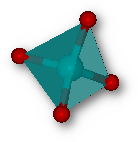Atomes offers all the standard tools that are expected by the scientist to analyze visually any atomistic model:
stylisation, measurements, custom labels, atom search engine, coordination polyhedras, and more.
Here are some innovative tools implemented in Atomes:
- Clones:
as an education tool for the case of periodic systems Atomes uses the idea of clones,
or replica images, of atoms linked via Periodic Boundary Conditions (PBC).
Theses extra atoms or clones can optionally be added to the model on the edges of the simulation box
to illustrate the real length and orientation of the chemical bonds found by using the PBC.
- Color maps:
atoms and polyhedra color maps can easily be fine-tuned in Atomes, several bonding-based color maps
are natively available: atomic species, total coordinations, partial coordinations, molecular fragments
(isolated objects), and molecules (topological analysis), classical MD force field numbering.
But it is also possible to read and use custom, user-defined, color map.
- Environments dialog:
Atomes offers an advanced configuration tool dedicated to the visual analysis of the structural
units in the atomistic model (coordination units, coordination polyhedra, rings, chains, fragments, molecules).
Using this tool scientists can customize the rendering to highlight whatever unit that requires
attention, furthermore that it can also be used to select atoms or objects for edition purposes.
- Video encoding:
Atomes offers real time encoding of the OpenGL window. Upon starting the recording all actions performed by the user are stored.
Then when stopping the recording, encoding becomes available and movies can be saved in different formats (MPEG, MP4, THEORA, H264, FLASH).
